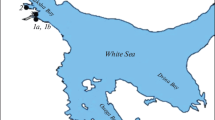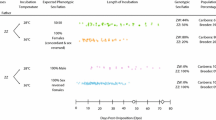Abstract
The sex ratios of the progenies of woodlice Porcellionides pruinosus (Crustacea, Isopoda) raised at different temperatures were studied. Females from three French populations sampled in the wild produced highly female-biased broods at 20°C and male-biased broods above 30°C. The effect of high temperature was not due to selective mortality of females. Sex determination was thus sensitive to temperature in P. pruinosus. We also found an interpopulation variability of sex ratio thermosensitivity and a weak inheritance of male-biased sex ratios at high temperatures. Samples taken from a wild population throughout the year showed that while the thermal conditions required for changes in the sex ratio occurred, there was no significant variation in the sex ratio. On the other hand, almost all the females and many males in the four populations studied harboured intracytoplasmic bacteria. These maternally inherited symbionts belong to the genus Wolbachia and are known to possess a feminizing effect. While in other arthropods Wolbachia are destroyed at high temperatures, the symbionts of P. pruinosus were detected by a PCR procedure whatever the rearing temperatures. In light of these results, we propose that the thermosensitivity of sex determination in P. pruinosus could reflect the removal of the cytoplasmic effect on sex determination rather than environmental sex determination sensu stricto. The reduction in the amount of bacteria (but not their entire elimination), or the inhibition of bacterial metabolism, may be responsible for sex ratio variations relating to temperature. The incomplete inheritance of male-biased sex ratios at high temperatures might reflect a selection of thermo-tolerant bacterial strains.
Similar content being viewed by others
References
Adams, J., Greenwood, P. and Naylor, C. (1987) Evolutionary aspects of environmental sex determination. Int. J. Invert. Reprod. Devel. 11, 123–136.
Beamish, F.W.H. (1993) Environmental sex determination in southern brook lamprey, Ichthyomyzon gagei. Can. J. Fish. Aquat. Sci. 50, 1299–1307.
Bougrier, S. (1978) Contribution à l'étude du crustacé isopode terrestre Metoponorthus pruinosus Brandt. Unpublished DEA dissertation, Université de Poitiers, Poitiers.
Bull, J.J. (1983) Evolution of Sex Determining Mechanisms. Benjamin/Cummings, Menlo Park, CA.
Bull, J.J. and Charnov, E.L. (1989) Enigmatic reptilian sex ratios. Evolution 43, 1561–1566.
Bulnheim, H.P. and Vavra, J. (1968) Infection by the microsporidian Octosporea effeminans and its sex determining influence in the amphipod Gammarus duebeni. J. Parasitol. 545, 241–248.
Charnov, E.L. and Bull, J.J. (1977) When is sex environmentally determined? Nature 266, 828–830.
Conover, D.O. and Heins, S.W. (1987a) The environmental and genetic components of sex ratio in Menidia menidia (Pisces: Atherinidae). Copeia 1987, 732–743.
Conover, D.O. and Heins, S.W. (1987b) Adaptative variation in environmental and genetic sex determination in a fish. Nature 326, 496–498.
Dangerfield, J.M. and Telford, S.R. (1990) Breeding phenology, variation in reproductive effort and offspring size in a tropical population of the woodlouse Porcellionides pruinosus. Oecologia 82, 251–258.
Dangerfield, J.M. and Telford, S.R. (1994) Population size structure and sex ratios in some woodlice (Crustacea: Oniscidea) from Southern Africa. J. Trop. Ecol. 10, 261–271.
Ginsburger-Vogel, T. and Desportes, I. (1979) Structure and biology of Marteilia sp. in the amphipod Orchestia gammarellus. Mar. Fish. Rev. 41, 3–7.
Ginsburger-Vogel, T. and Magniette-Mergault, F. (1981a) The effects of temperature on sexual differentiation in the temperature sensitive thelygenic-intersexual offspring of Orchestia gammarellus (Pallas) (Amphipoda, Crustacea). I. Effects of temperature on pubescent females. Int. J. Invert. Reprod. 4, 39–50.
Ginsburger-Vogel, T. and Magniette-Mergault, F. (1981b) The effects of temperature on sexual differentiation in the temperature sensitive thelygenic-intersexual offspring of Orchestia gammarellus (Pallas) (Amphipoda, Crustacea). II. Effects of temperature during embryonnic and post-embryonnic development. Int. J. Invert. Reprod. 4, 51–65.
Hipeau-Jacquotte, R. (1988) Environmental sex determination in a crustacean parasite. Int. J. Invert. Reprod. Devel. 14, 11–24.
Juchault P., Legrand, J.J. and Martin, G. (1974) Action interspécifique du facteur épigénétique féminisant responsable de la thélygénie et de l'intersexualité du Crustacé Armadillidium vulgare (Isopode Oniscoide). Ann. Embryo. Morphogen. 7, 265–276.
Juchault, P., Martin, G. and Legrand, J.J. (1980) Induction par la température d'une physiologie mâle chez les néo-femelles et les intersexués du Crustacé oniscoide Armadillidium vulgare Latr. hébergeant un bacteroide a action féminisante. Int. J. Invertebr. Reprod. 2, 223–235.
Juchault, P., Rigaud, T. and Mocquard, J.P. (1993) Evolution of sex determination and sex ratio variability in wild populations of Armadillidium vulgare Latr. (Crustacea, Isopoda). Acta Oecologica 14, 547–562.
Juchault, P., Frelon, M., Bouchon, D. and Rigaud, T. (1994) New evidence for feminizing bacteria in terrestrial isopods: Evolutionary implications. C.R. Acad. Sci. Paris Life Sci. 317, 225–230.
Kocher, T.D., Thomas, W.K., Meyer, A., Edwards, S.V., Pääbo, S., Villablanca, F.X. and Wilson, A.C. (1989) Dynamics of mitochondrial DNA evolution in animals: Amplification and sequencing with conserved primers. Proc. Natl. Acad. Sci. USA 86, 6196–6200.
Legrand, J.J., Legrand-Hamelin, E. and Juchault, P. (1987) Sex determination in Crustacea. Biol. Rev. 62, 439–470.
Louis, C., Pintureau, B. and Chapelle, L. (1993) Recherches sur l'origine de l'unisexualité: la thermothérapie élimine à la fois rickettsies et parthénogenèse thélytoque chez un Trichogramme (Hym. Trichogrammatidae). C. R. Acad. Sci. Paris III 316, 27–33.
Martin, G., Juchault, P. and Legrand, J.J. (1973) Mise en évidence d'un micro organisme intracytoplasmique symbiote de l'Oniscoïde Armadillidium vulgare L., dont la présence accompagne l'intersexualité ou la féminisation totale des mâles génétiques de la lignée thélygène. C.R. Acad. Sci. Paris III 276, 2313–2316.
Martin, G., Gruppe, S., Laulier, M., Bouchon, D., Rigaud, T. and Juchault, P. (1994) Evidence for Wolbachia spp. in the estuarine isopod Sphaeroma rugicauda (Crustacea): A likely cytoplasmic sex ratio distorter. Endocytobiosis Cell Res. 10, 215–225.
Naylor, C., Adams J. and Greenwood P.J. (1988) Variation in sex determination in natural populations of a shrimp. J. Evol. Biol. 1, 355–368.
O'Neill, S.L., Giordano, R., Colbert, A.M.E., Karr, T.L. and Robertson, H.M. (1992) Phylogenetic analysis of the bacterial endosymbionts associated with cytoplasmic incompatibility in iinsects. Proc. Natl. Acad. Sci. USA 89, 2699–2702.
Rigaud, T. and Rousset, F. (1996) What generates the diversity of Wolbachia—arthropod interactions? Biodiv. Conserv. 5, 999–1013.
Rigaud, T., Juchault, P. and Mocquard, J.P. (1991a) Experimental study of temperature effects on the sex ratio of broods in terrestrial Crustacea Armadillidium vulgare Latr. Possible implications in natural populations. J. Evol. Biol. 4, 603–617.
Rigaud, T., Souty-Grosset, C., Raimond, R., Mocquard, J.P. and Juchault, P. (1991b) Feminizing endocytobiosis in the terrestrial crustacean Armadillidium vulgare Latr. (Isopoda): Recent acquisitions. Endocytobiosis Cell Res. 7, 259–273.
Rousset, F., Bouchon, D., Pintureau, B., Juchault, P. and Solignac, M. (1992) Wolbachia endosymbionts responsible for various alterations of sexuality in Arthropods. Proc. Roy. Soc. Lond. B 250, 91–98.
Sutton, S.L., Hassall, M., Willows, R., Davis, R.C., Grundy, A. and Sunderland, K.D. (1984) Life histories of terrestrial isopods: A study of intra-and interspecific variation. Symp. Zool. Soc. Lond. 53, 269–294.
Taylor, D.R. (1990) Evolutionary consequences of cytoplasmic sex ratio distorters. Evol. Ecol. 4, 235–248.
Watt, P.J. and Adams, J. (1993) Adaptative sex determination and population dynamics in a brackish-water Amphipod. Estuar. Cstl. Shelf Sci. 37, 237–250.
Werren, J.H. and Charnov, E.L. (1978) Facultative sex ratios and population dynamics. Nature 272, 349–350.
Author information
Authors and Affiliations
Rights and permissions
About this article
Cite this article
Rigaud, T., Antoine, D., Marcade´, I. et al. The effect of temperature on sex ratio in the isopod Porcellionides pruinosus: Environmental sex determination or a by-product of cytoplasmic sex determination?. Evolutionary Ecology 11, 205–215 (1997). https://doi.org/10.1023/A:1018404000804
Issue Date:
DOI: https://doi.org/10.1023/A:1018404000804




